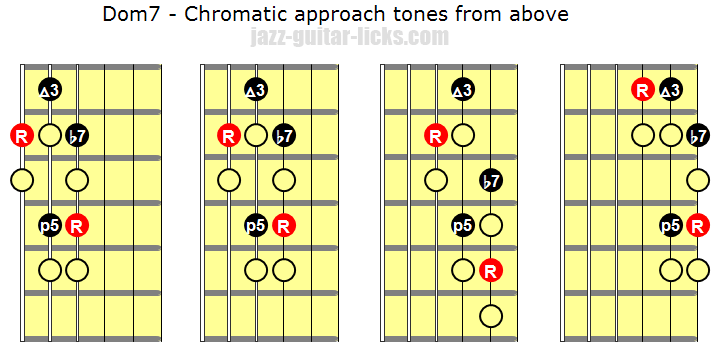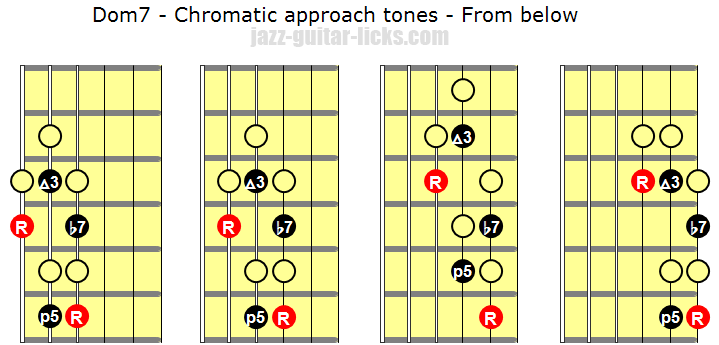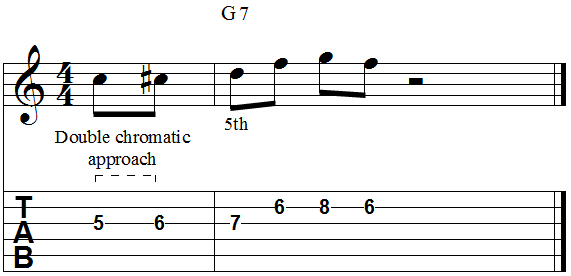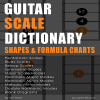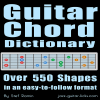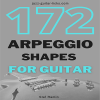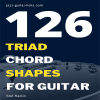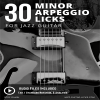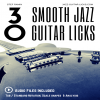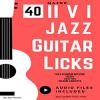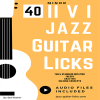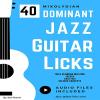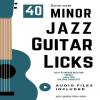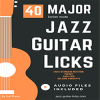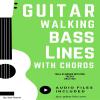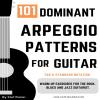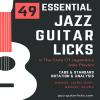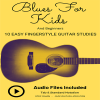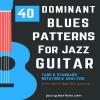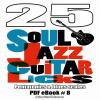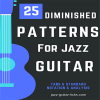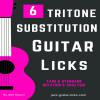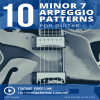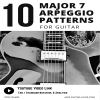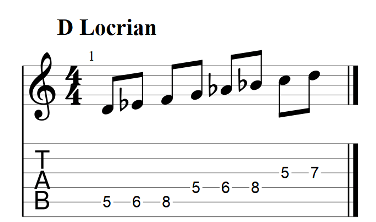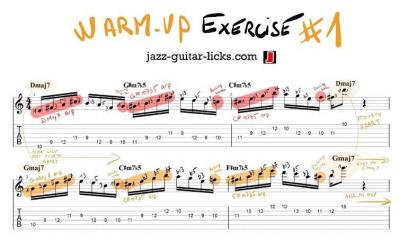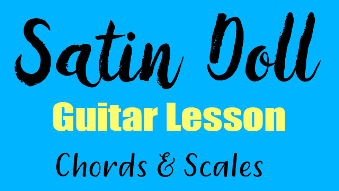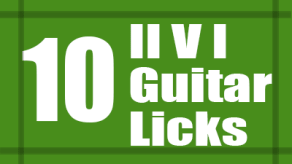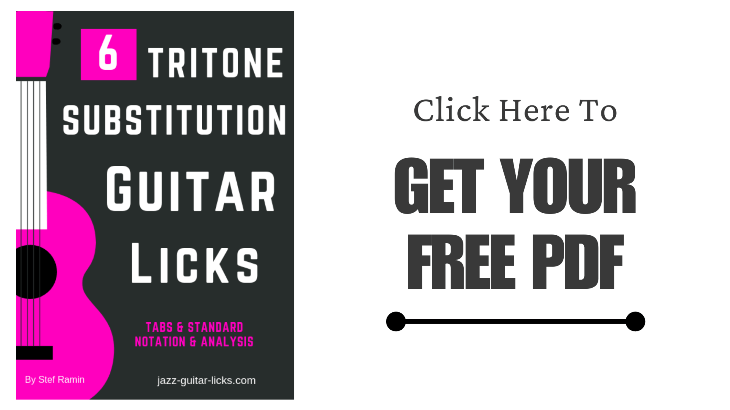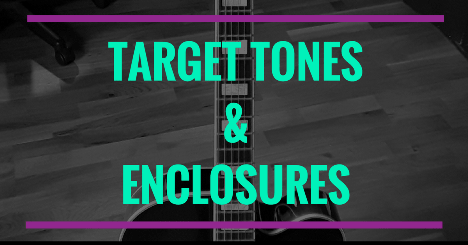
Target Tones and Enclosures - 58 Guitar Patterns
- By jazz-guitar-licks
- On 2018-05-20
- In Jazz Guitar Lessons
- 6 comments
This guitar lesson is about a very important concept used by many jazz improvisers named "Target notes" or "target tones" or "approach notes". It has to do with targeting chord tones by scale or chromatically.
This technique opens the door to another essential type of targeting called "Enclosures" used to surround a chord tone both diatonically and chromatically from above and below.
Understanding and applying "Targeting" will help you solos sound more jazzy and allow you to expand your harmonic knowledge.
How to Target Chord Tones
There are many ways to target chord tones. You can use ascending or descending approach notes either diatonic or chromatic. The exercises below show you how to use approach notes in order to target a particular chord tone.
It goes without saying that these exercises may be used to any chord type as minor, dominant 7, half-diminished, diminished, etc. Please notice that the "target note" are usually played on the downbeat.
Single Diatonic Approach Notes
The term “diatonic” means that we will use the notes of the major scale. The principle is to play the notes of the scale that are located just before (below) or after (above) the "target note".
For example and for more clarity the chord tones are from a C major seventh chord, they represent the most important notes in the chord (root, third, fifth, seventh). So, the target notes will be C (the root), E (the third), G (the fifth) and B (the seventh).
The following diagrams show the relationship between the approach notes (represented by a transparent circle) and the target tones of a major 7 chord.
Here are eight patterns that show how to target a major 7 chord tone using the single diatonic approach technique.
Chord root
Chord root - Diatonic Ascending
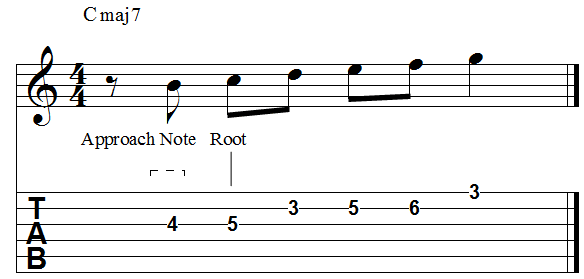
Chord root - Diatonic Descending
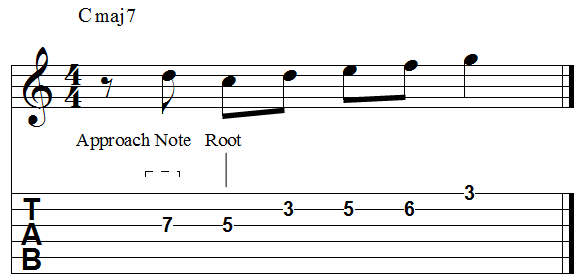
Chord 3rd
Chord 3rd - Diatonic Ascending
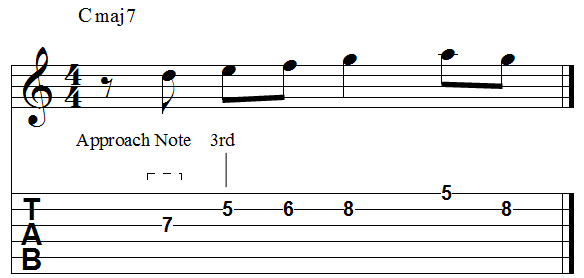
Chord 3rd - Diatonic Descending
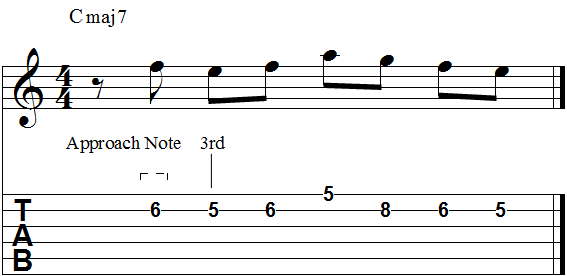
Chord 5th
Chord 5th - Diatonic Ascending
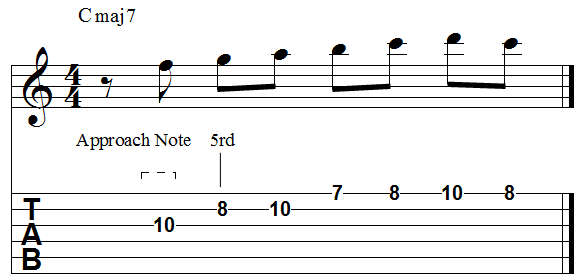
Chord 5th - Diatonic Descending
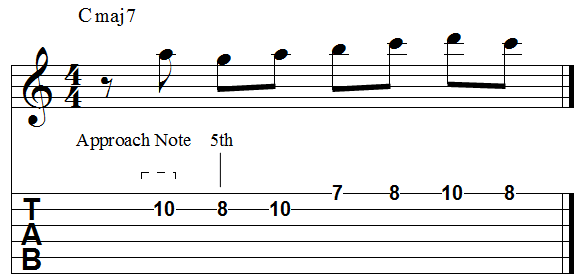
Chord 7th
Chord 7th - Diatonic Ascending
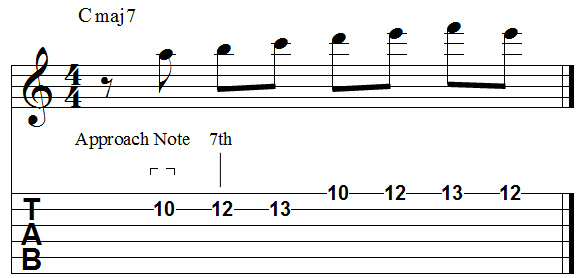
Chord 7th - Diatonic Descending
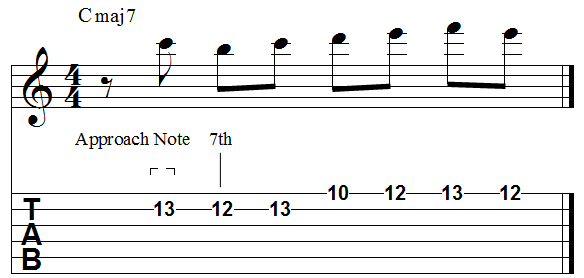
Double Diatonic Approach Notes
The double diatonic approach consist of playing two notes of the diatonic scale in order to target a chord tone.
When using this concept with the aim of targeting from below :
- The chord root, you always play the 6th and the 7th before.
- The chord third, you always play the root and the 2nd before.
- The chord fifth, you always play the minor 3rd and the 4th before.
- The chord seventh, you always play the 5th and the 6th before.
When using this concept with diatonic notes from above :
- The chord root, you always play the 3rd and the 2nd before.
- The chord third, you always play the 5th and the 4th before.
- The chord fifth, you always play the 7th and the 6th before.
- The chord seventh, you always play the 2nd and the root before.
Here are eight guitar patterns based on a C major seventh chord which, it should be remembered, is built with : root (C), third (E), fifth (G) and seventh (B). Each chord tone is approached diatonically from above and from below.
Chord root
Double diatonic approach from below
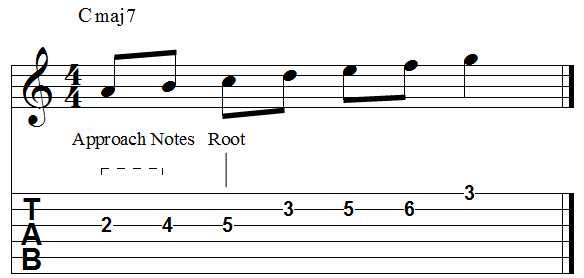
Double diatonic approach from above
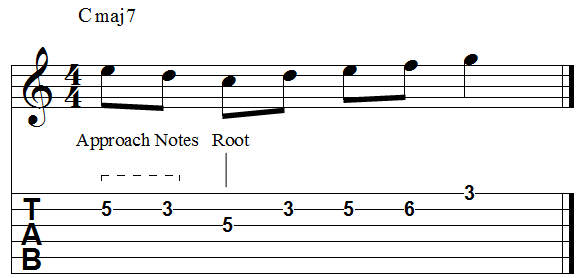
Chord 3rd
Double diatonic approach from below
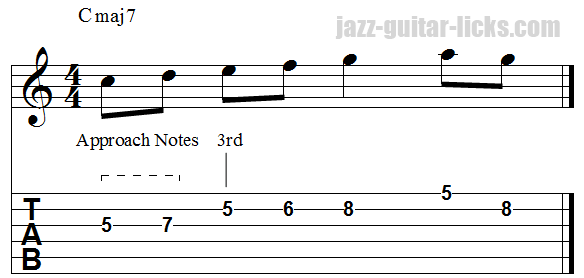
Double diatonic approach from above
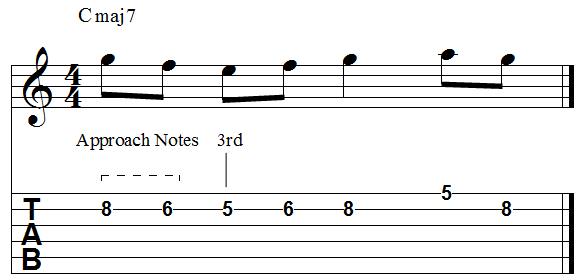
Chord 5th
Double diatonic approach from below
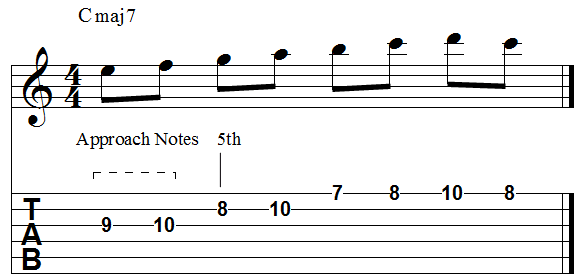
Double diatonic approach from above
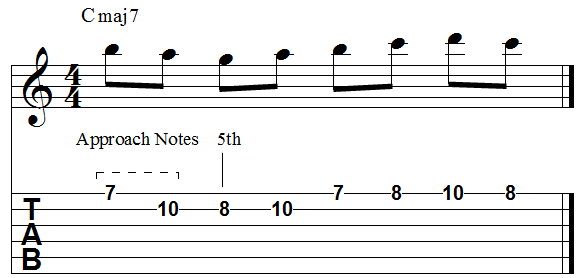
Chord 7th
Double diatonic approach from below
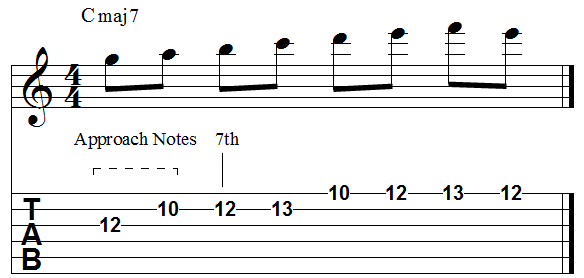
Double diatonic approach from above
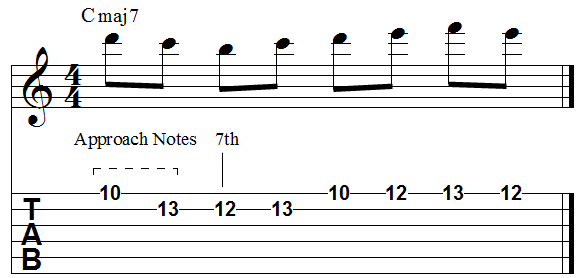
Single Chromatic Approach Notes
The second way to target notes is to use chromatic approach tones. It means that you will be playing in your jazz improvisations, notes that don't belong to the tonality. Each chromatic tones will be played on an offbeat a semitone below or above each tones of a chord.
For the following exercises we will be targeting the root (R), the major third (3), the fifth (5) and the minor seventh (b7) of G7. Be sure to do the same work with the main types of triads (minor, major, diminished, augmented) and arpeggios as minor 7 (R-b3-5-b7), major 7 (R-3-5-7), diminished 7th (R-b3-b5-bb7), half-diminished (R-b3-b5-b7).
Chord root
Chord root - Chromatic Ascending
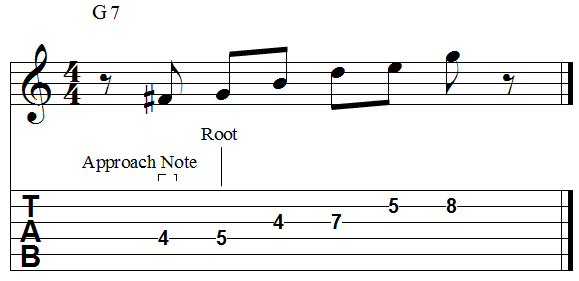
Chord root - Chromatic Descending
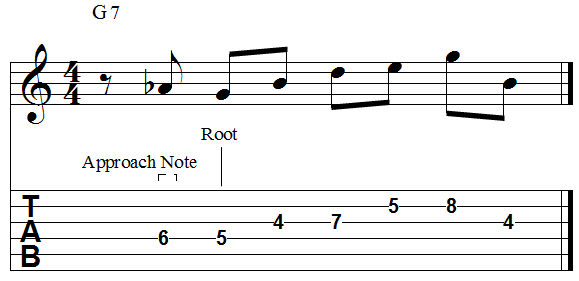
Chord 3rd
Chord 3rd - Single Chromatic Ascending
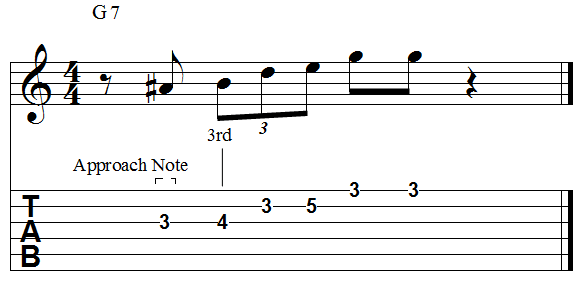
Chord 3rd - Single Chromatic Descending
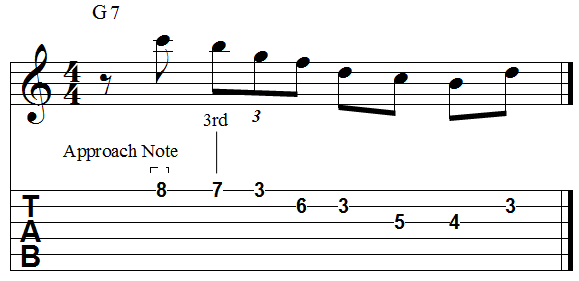
Chord 5th
Chord 5th - Chromatic Ascending

Chord 5th - Chromatic Descending
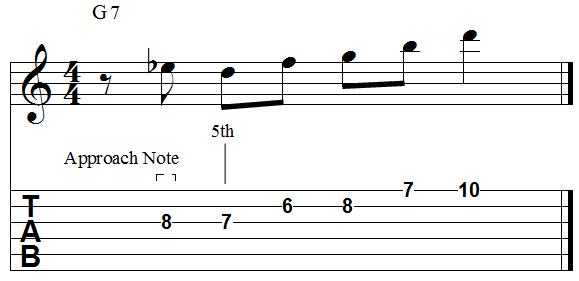
Chord 7th
Chord 7th - Chromatic Ascending
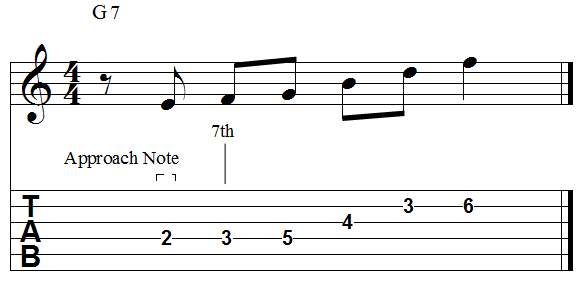
Chord 7th - Chromatic Descending
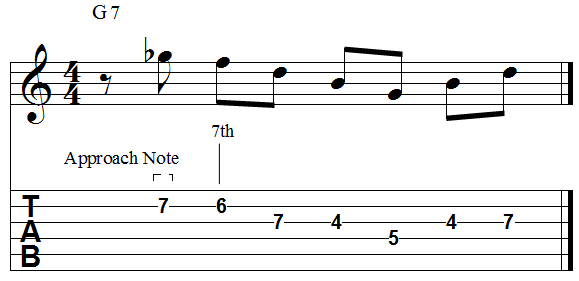
Double Chromatic Approach Notes
Now that you understand the principle of the single chromatic approach you can make this concept more interesting by playing two chromatic notes from above or from below to target a note of any type of chord.
This technique is a terribly efficient tool when employed over a dominant 7 chord, this will allow you to create short chromatic lines as a bebop player would do.
These six short jazz guitar lines below show you how to approach chromatically each tone of a dominant 7 chord with two notes.
Please, notice that the two examples "chord third double chromatic approach from above" and "chord seventh double chromatic approach from below" imply two dissonant notes on the downbeat, the #11 for the first examples and the b13 for the second. They don't sound very good at all but can be useful for outside playing.
Chord root
Double chromatic approach - Above
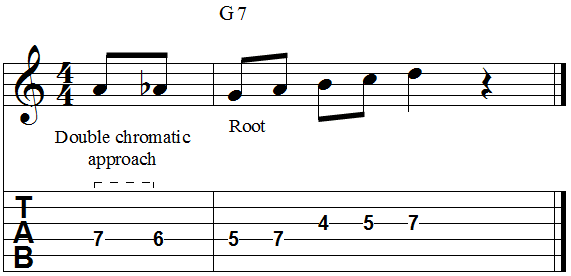
Double chromatic approach - Below
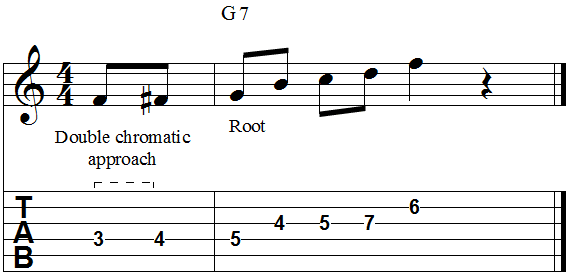
Chord third
Double chromatic approach - Below
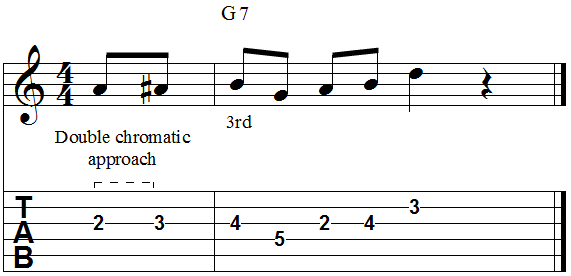
Double chromatic approach - Above
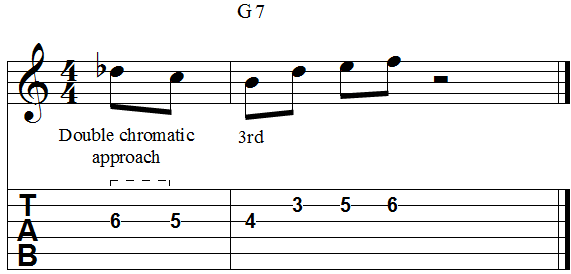
Chord fifth
Double chromatic approach - Above
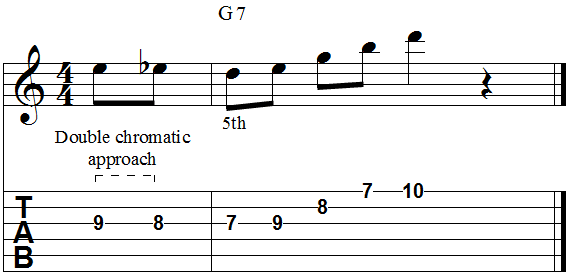
Double chromatic approach - Below
Chord seventh
Double chromatic approach - Above
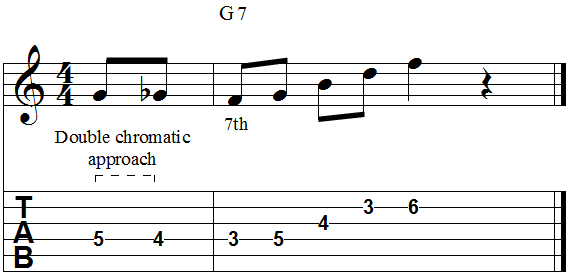
Double chromatic approach - Below
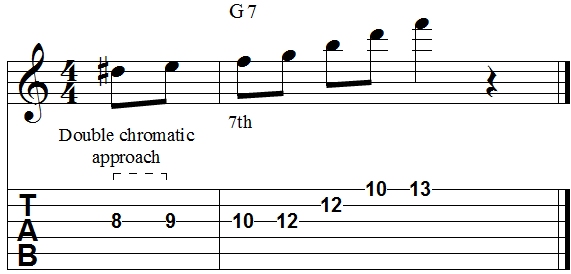
What's An Enclosure
Enclosures are a very important part of the jazz language especially used by bebop players. They are present in many essential jazz lines. This technique consists in approaching a target note with a group of two, three or four notes from above or from below either with a whole step (2 semitones) or a half step (1 semitone).
Enclosures, also known as encapsulations, will help you achieve two main goals, they are a great way to insert chomaticisms in your improvisations and great way to extend your jazz lines.
Diatonic Enclosures
A diatonic enclosure is characterized by surrounding a chord tone above or below using notes within the diatonic scale. You need to know first that a dominant 7 chord is built with Root (R), major third (3), perfect fifth (5) and minor seventh (b7) meaning that G7 contains G (R) - B (3) - D (5) and F (b7).
So, we can use two notes to approach diatonicaly each tone of G7. G, the root, can be enclosed with F and A. B, (the third) can be enclosed with C and A. D (the fifth) can be enclosed with C and E. Then, F (the minor seventh) can be enclosed with E and G.
The four guitar shapes below help you see clearly the location of the approach notes (transparent circle) in relation with the dominant 7 arpeggios.
The eight enclosure patterns in fretboard diagrams, TAB and notation below show you how you can approach diatonically each note a G7 chord from above and from below.
Chord root
Chord root diatonic enclosure - Above and below
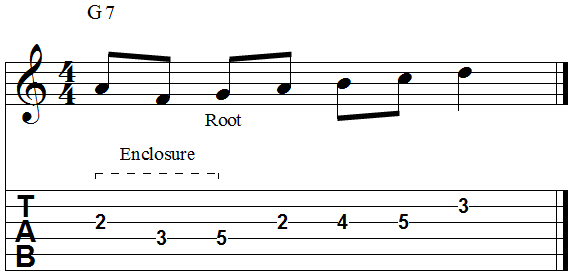
Chord root diatonic enclosure - Below and above
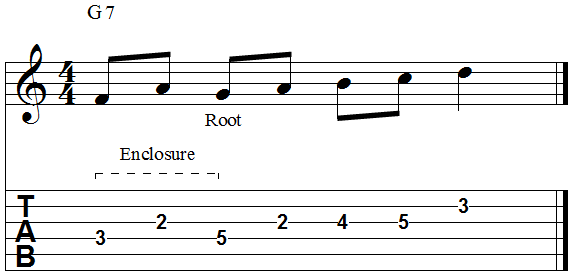
Chord 3rd
Chord 3rd diatonic enclosure - Above and below
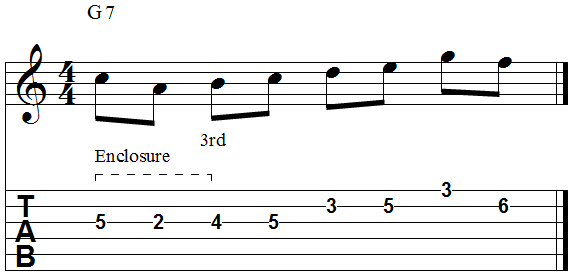
Chord 3rd diatonic enclosure - Below and above
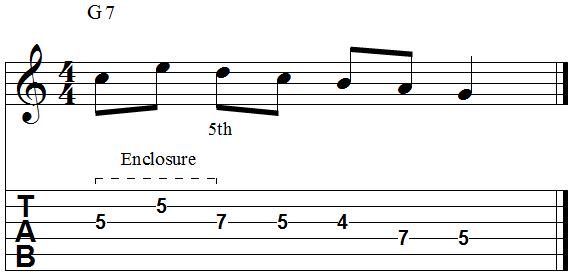
Chord 5th
Chord 5th diatonic enclosure - Above and below
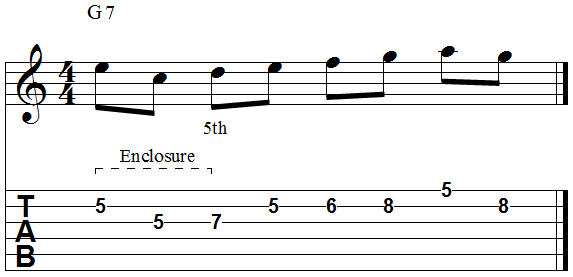
Chord 5th diatonic enclosure - Below and above
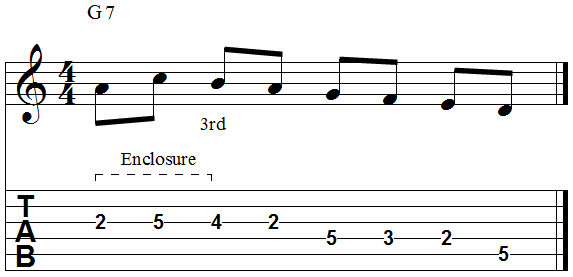
Chord 7th
Chord 7th diatonic enclosure - Above and below
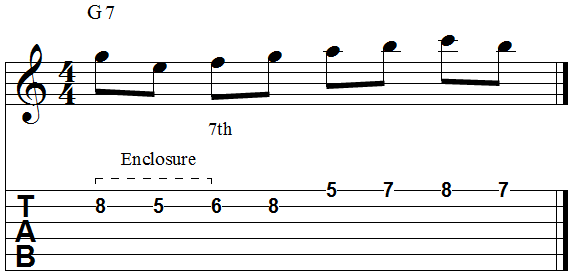
Chord 7th diatonic enclosure - Below and above
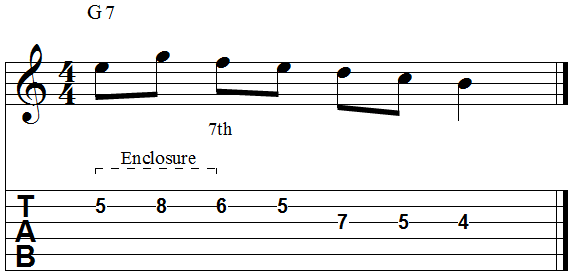
Chromatic Enclosures - Below and above
As the title of this chapter implies, a chord tone can be enclosed chromatically from below and above. This is the simplest way to target notes, but it should be played with care because some of these chromatic enclosure patterns can be very dissonant.
Therefore, if you want to bring a little bit of tension to your jazz improvisations, then you are at the right place ! Try these four easy jazz lines below and judge for yourself.
Chord root
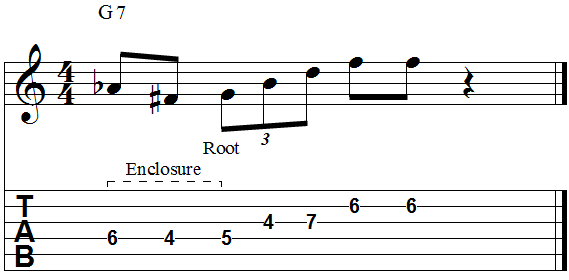
Chord 3rd
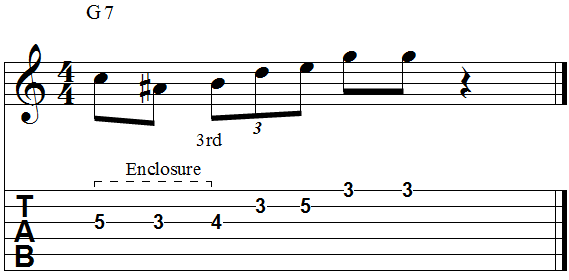
Chord fifth
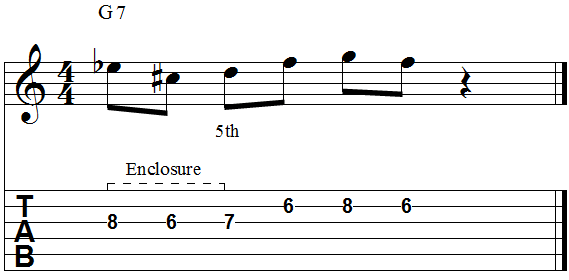
Chord seventh
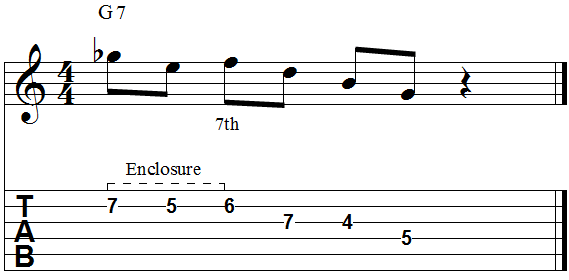
Diatonic And Chromatic Enclosures - Mixed Enclosure
Many jazz musicians use a mix of chromatic and diatonic approaches to target a note. The next guitar lines involve targeting chord tones of G7 using scale tones above / chromatic tones below and scale tones below / chromatic tones above. These are the most commonly used enclosures in jazz improvisation, both by guitarists and pianists and any other jazz musicians.
This chapter of this free complete guide for guitar student will run through eight easy examples of the diatonic/Chromatic enclosure on the root, third, fifth and seventh of a dominant chord. Don't forget to apply these concepts about target notes to any type of chord in order to create your own jazz lines.
Chord root
Chord root enclosure - Scale tone above - Chromatic tone below
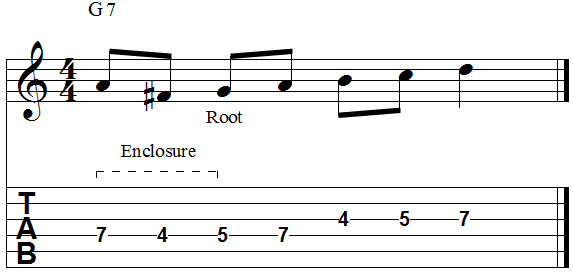
Chord root enclosure - Scale tone below - Chromatic tone above
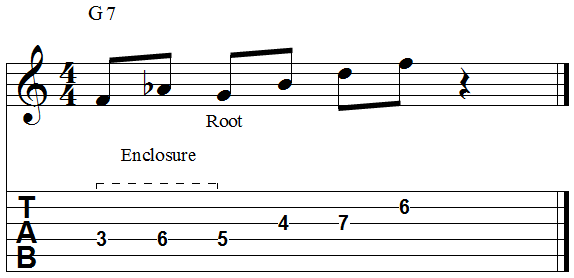
Chord 3rd
Chord 3rd enclosure - Scale tone above - Chromatic tone below
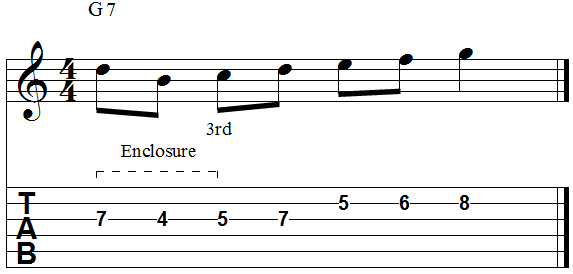
Chord 3rd enclosure - Scale tone above - Chromatic tone below

Chord 5th
Chord 5th enclosure - Scale tone above - Chromatic tone below
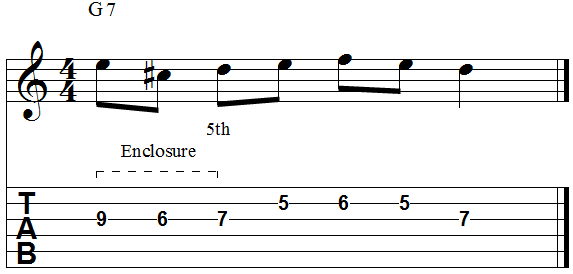
Chord root 5th - Scale tone above - Chromatic tone below

Chord 7th
Chord 7th enclosure - Scale tone below - Chromatic tone above
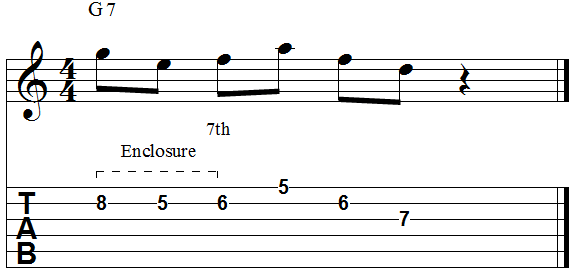
Chord 7th enclosure - Scale tone above - Chromatic tone below

Multi-note Enclosures
You can use more than two notes to target a chord tone while combining the previous concepts discussed in this lesson. This should add a lot of interest to your jazz guitar solos.
3 note enclosures
There are a lot of possibilities to enclose a chord tone using three notes. A few examples of how it would apply to the root of a G7 chord are represented below. Be sure to use this concept with all the other chord tones (third, fifth and seventh) of any chord type.
Chord root - 3 note enclosure
Enclosure of root using whole-step above to half-step above to half-step below.
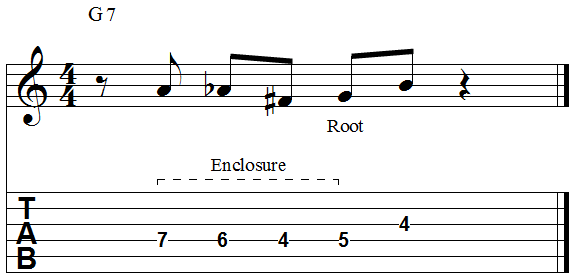
Chord root - 3 note enclosure
Enclosure of root using half-step below to whole-step above to half-step above.
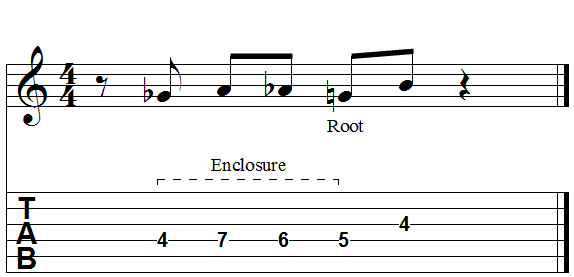
Chord root - 3 note enclosure
Enclosure of root using whole-step above to half-step below to half-step above.
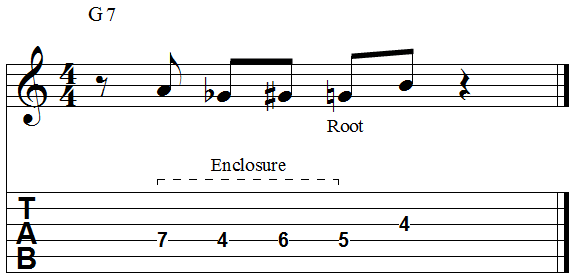
4-note enclosures
The three following patterns illustrate the notes of a G7 chord being enclosed with 4 notes. The possibilities are almost unlimited, so you have to experiment with this technique of targeting with four notes in order to create your own bebop lines.
Chord root - 4 note enclosure
Enclosure of root - Whole-step above, half-step above, whole-step below and half-step below.
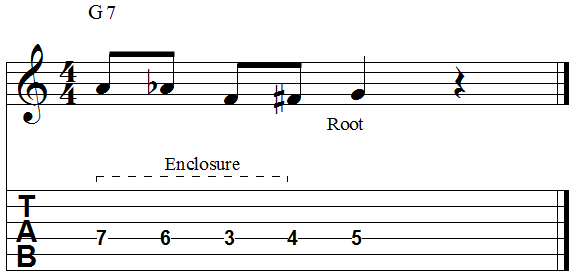
Chord root - 4 note enclosure
Enclosure of root - whole-step above, half-step above, half-step below and whole-step below.
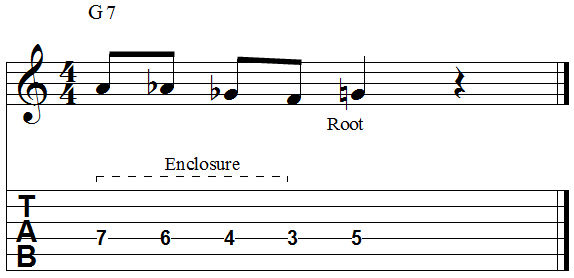
Chord root - 4 note enclosure
Enclosure of root - Whole-step below, half-step above, half-step below and whole-step above.
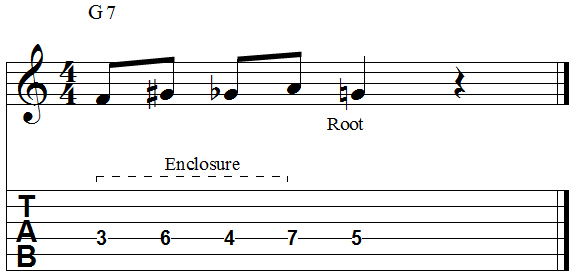
-
Guitar Scale Dictionary
This E-book is a printable PDF method including over 700 scale diagrams and formula charts for guitarists. -
30 Groovy Jazz Guitar Licks
This downloadable package contains a PDF WITH audio files giving access to 30 groovy guitar phrases mixing jazz, blues and funky licks for beginners. -
Guitar Chord Dictionary
This PDF eBook provides over 550 guitar chord shapes. This is the perfect reference guide to understand how chords are built and how to play them on the guitar neck. -
172 Arpeggio Shapes For Guitar
This printable PDF is a method dedicated to guitarists of all styles who want to learn the most important types of arpeggios. -
126 Triad Chord Shapes
This handbook for guitar players is intended both for teachers and students. It includes 126 guitar shapes for mastering triads. -
30 Minor Arpeggio Licks
This package includes a printable PDF method containing 30 exercises with tabs, staves and audio files for practicing minor arpeggios on guitar. -
II V I Bundle - 170 Exercises
This bundle contains 4 PDF methods for a total of 170 exercises with tabs, staves, analysis & audio files for practicing scales, arpeggios licks & chords over the 2-5-1 progression. -
Diatonic Licks Bundle
This package contains 120 jazz guitar lines based on diatonic modes as Mixolydian, Dorian and Ionian. PDF format with tabs, audio files and analysis. -
30 Smooth Jazz Guitar Licks
In this package you'll get a printable PDF Method with tabs, notation, analysis, scale shapes and audio files for practicing 30 smooth jazz guitar licks. -
40 II V I Jazz Guitar Licks
This pdf method for guitar contains fourteen 2 5 1 jazz guitar lines with tab, standard notation, analysis, scale charts and audio files. -
50 II-V-I voicings
This printable PDF guitar method provides 50 exercises with audio files, analysis, tab and staves for learning major 2-5-1 chord voicings. -
40 Minor 2 5 1 Chord Voicings
This PDF method contains 40 exercices with tabs, scores and audio files for practicing jazz guitar chords over the minor 2 5 1 progression. -
40 Minor II V I Licks
This guitar method is a printable PDF with tabs, diagrams, theory and audio files providing 40 minor 2 5 1 jazz patterns. -
40 Mixolydian Jazz Guitar Lick
PDF guitar method with tabs, audio files and theory providing 40 dominant jazz guitar lines for teachers and students. -
40 Minor Jazz Guitar Licks
This printable guitar method in PDF format contains 40 easy minor jazz guitar lines based on the Dorian mode. -
40 Major Jazz Guitar Licks
Printable PDF eBook method containing 40 major jazz guitar licks with tab, standard notation and audio files for beginners and intermediates. -
Guitar Walking Bass Lines
This jazz guitar method about walking bass lines and chords is available as a PDF files containing 35 exercises with tabs, analysis and audio files -
101 Dominant Arpeggio Patterns
This printable PDF method provides 101 dominant arpeggio exercises with tab, theory and standard notation for the jazz, blues and rock guitarist. -
49 Essential Jazz Lines
This printable eBook method in PDF format provides 49 jazz solo transcriptions of the greatest jazz musicians. Tab, standard notation, audio files & analysis. -
11 Jazz Blues Studies
11 jazz blues chord studies with tabs, standard notation, analysis, and audio recordings and PDF. -
10 Easy Fingerstyle Blues
This PDF with Tabs and audio files provides 10 easy acoustic fingerstyle blues guitar studies for kids and beginners. -
25 Altered Jazz Guitar Lines
This PDF eBook method contains 25 altered jazz guitar licks with tabs, patterns, scale charts and audio files to master, apply and develop the altered scale. -
40 Blues Dominant Patterns
This printable method is available as a PDF file containing 40 easy dominant jazz-blues guitar lines with tabs, standard notation, analysis, audio files and scale charts. -
Mastering Pentatonic Scales
This jazz guitar method is an eBook available as a PDF with standard notation, guitar tabs, diagrams, analysis, audio files and backing tracks. You will find in this booklet 25 easy jazz guitar lines with theory using common and rare pentatonic scales. -
25 Soul Jazz Guitar Licks
You will find here an eBook available in PDF containing 25 soul jazz and hard bop guitar licks in the style of Grant Green, Melvin Sparks, George Benson. These jazz lines come with tabs, standard notation, guitar neck diagrams, backing track for practice and 25 audio files for each riff. -
25 Diminished Patterns
This eBook PDF with audio files contains 25 dominant diminished jazz guitar patterns using the half-whole diminished scale and diminished 7th arpeggios. -
6 Tritone substitution licks
This Printable PDF eBook available for free download contains 6 easy jazz guitar licks with tabs/notation, youtube video link and analysis about the tritone substitution. -
10 Minor 7 Arpeggio Patterns
This printable PDF eBook offers 10 easy minor 7 arpeggio patterns with its related YouTube video for beginner guitarists. -
10 Easy Major 7 Arpeggio Licks
This is a printable PDF for beginner jazz guitar players providing 10 easy licks to practice major 7 arpeggios. -
10 Chord Melody Lines
Within this package, you'll discover a set of ten chord melody exercises for beginners. Printable PDFaudio files, a backing track, and a link to the associated YouTube video. -
10 Minor Blues Scale Licks
You'll find here a PDF with 10 easy jazz guitar licks to practice the minor blues scale on guitar.
jazz guitar solo lesson jazz guitar patterns improvisation targeting Enclosures
Comments
-

- 1. Michael On 2024-03-11
Great info here, thanks for the awesome study guide!
Though I think there's a typeO in the "Diatonic Enclosures" section.
You write: "So, we can use two notes to approach diatonicaly each tone of G7. G, the root, can be enclosed with F# and A."
Diatonically it would be an F natural.-
- jazz-guitar-licksOn 2024-03-14
Corrected thanks.
-

- 2. Guitar Parts On 2023-02-12
Scale steps are another confinement jazz artists use to focus on notes. Scale steps are nothing more than notes from the chord's parent scale. For instance, D and F are notes that come from the C Mixolydian scale and can be used to enclose the 3rd (E) in a C7 arpeggio. You can develop the skills to become a better guitarist by comprehending the basic functions of the guitar and guitar parts.-
- jazz-guitar-licksOn 2023-04-13
Thanks for your comment.
-

- 3. Jefferson On 2020-11-03
Sou estudante de música gostaria de receber pdfs sobre música. Obrigado.-
- jazz-guitar-licksOn 2020-11-03
Here they are https://www.jazz-guitar-licks.com/pages/e-books/
Add a comment


